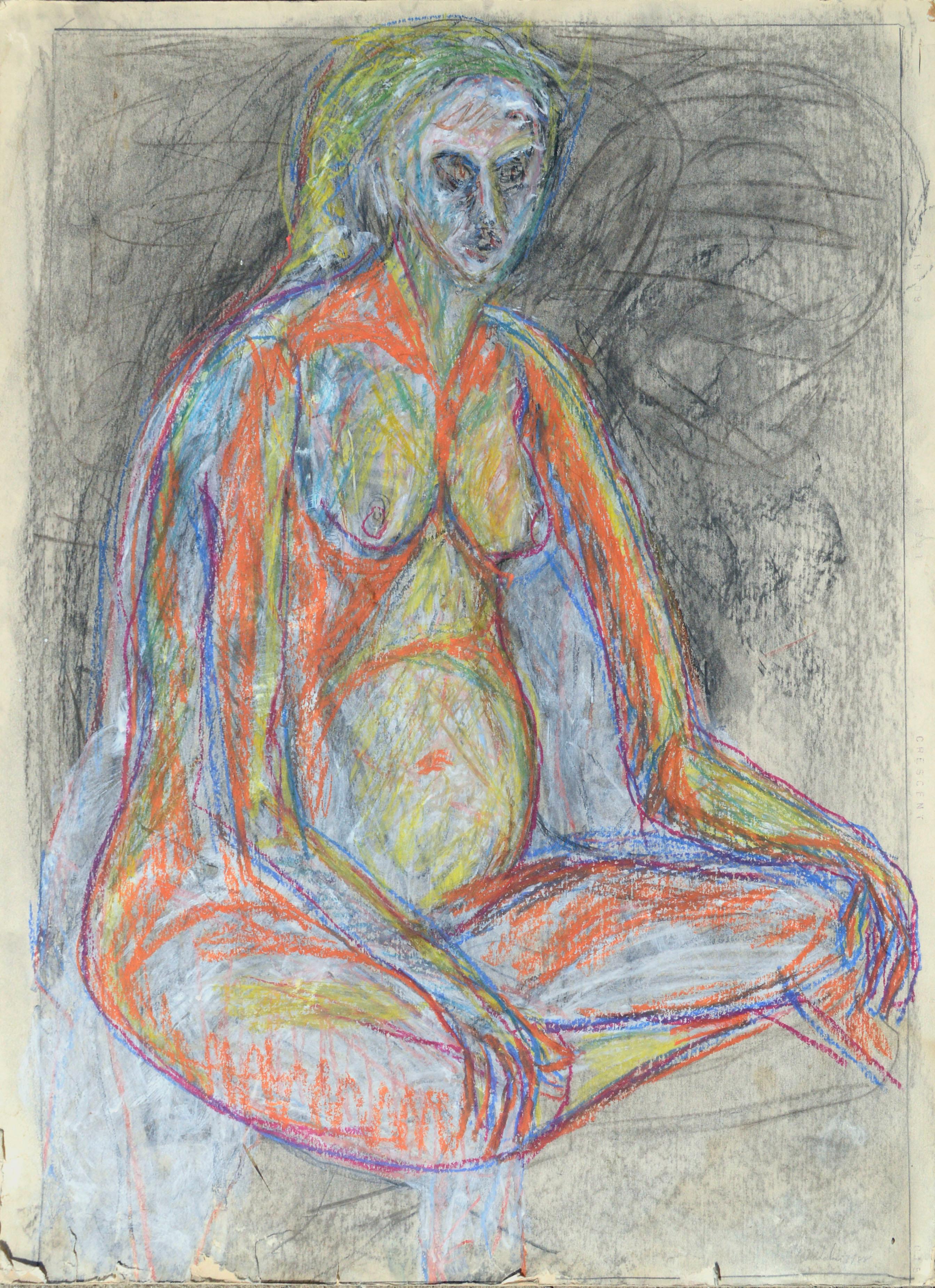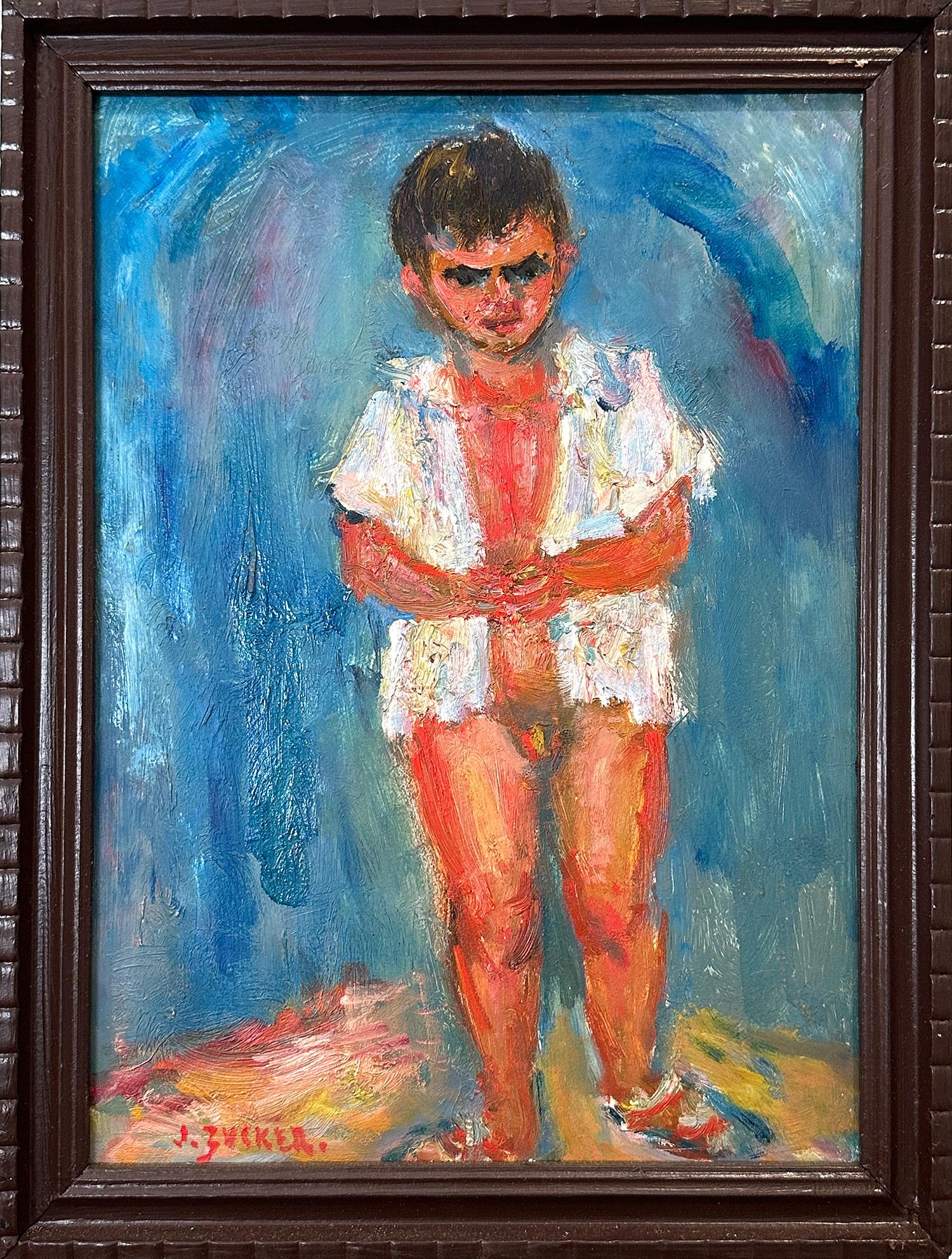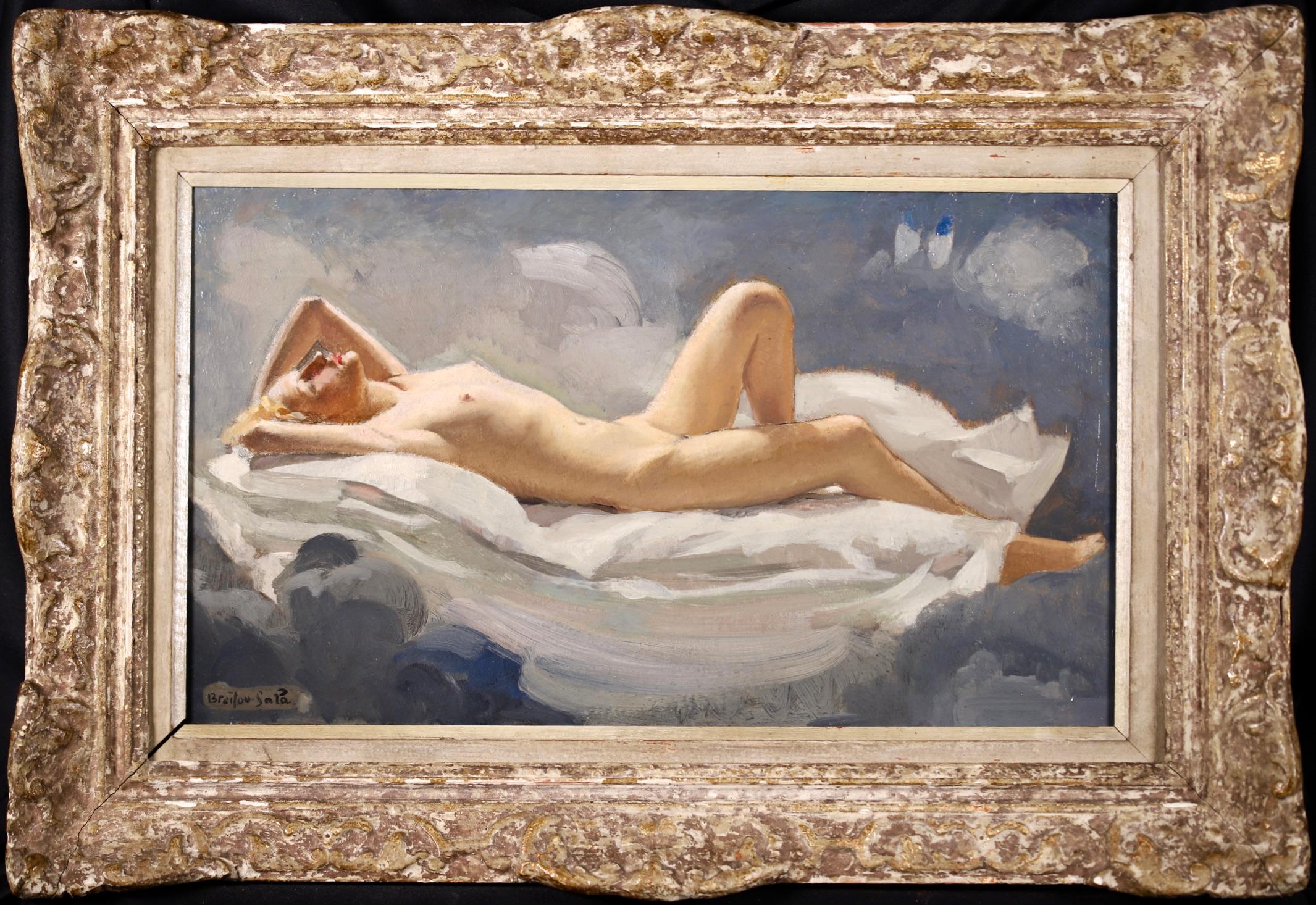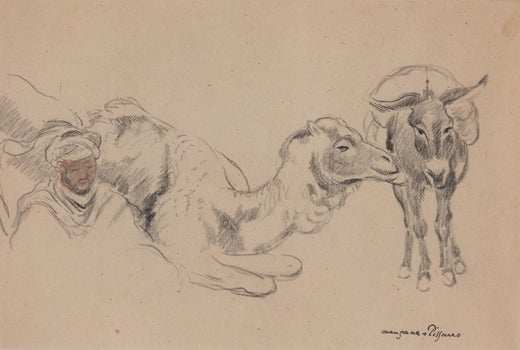Georges Henri Manzana PissarroBaigneuses en Bord de Rivière by Georges Manzana Pissarro - Nude painting1910
1910
About the Item
- Creator:Georges Henri Manzana Pissarro (French)
- Creation Year:1910
- Dimensions:Height: 38.67 in (98.2 cm)Width: 31.26 in (79.4 cm)
- Medium:
- Movement & Style:
- Period:
- Condition:
- Gallery Location:London, GB
- Reference Number:1stDibs: LU261210600092
Georges Henri Manzana Pissarro
Georges-Henri Pissarro, better known as Manzana, was born in Louveciennes, the third of Camille Pissarro and Julie Vellay’s seven children.
He studied with his father from a very early age and, like Lucien — Camille and Julie's eldest son — he spent his formative years surrounded by distinguished artists of the Impressionist movement, such as Monet, Cézanne, Renoir and Gauguin, all of whom frequented the Pissarro home. At his father's side he learned not only to handle brush and pencil but also to observe and to love nature.
Thus steeped in tradition and subjected to these diverse influences, Manzana turned out to be a prolific and versatile artist, producing work in oil, pastel and watercolour. As a young man he adopted his father's purely Impressionist style and produced a series of landscapes around Pontoise and Eragny. However, around 1906 he progressed beyond that and went in search of other means of expression via the design of furniture and decorative objects. The influence of Gauguin's exotic native scenes from Tahiti and Martinique certainly contributed to the development of Manzana's Orientalism, which at this time began to manifest itself in some of his paintings by his experimenting with gold, silver and copper paint.
Like all the second generation Pissarro artists, Georges initially worked under an assumed name. In 1894 he adopted "Manzana,” the family name of his maternal grandmother, and it was not until 1910, out of respect to his then-deceased father, that he employed his own family name when signing his work.
During the early 1900s Manzana regularly exhibited Impressionist works at the Salon d'Automne and the Salon des Indépendants, as well as Durand Ruel and Druet in Paris. In 1907 he had his first exhibition of decorative works at Vollard, but it was in 1914 that he had the most important exhibition of his career at the Musée des Arts Décoratifs, where he exhibited 311 works including tapestries, carpets, furniture, glassware, decorative paintings, etchings and lithographs.
Manzana continued to exhibit his work regularly until the late 1930s, splitting his time between Les Andelys and Paris, although spending several summers at Pont Aven in Brittany, where the local costume and lifestyle inspired a series of paintings in the 1930s. At the declaration of war in 1939, he moved with his family to Casablanca, where he stayed until 1947.
Manzana was married and widowed three times. He spent the last years of his life with Félix, his youngest son who was also an accomplished artist, in Menton, returning to the Impressionist tradition and painting the local landscape.
(Biography provided by Stern Pissarro Gallery)
- ShippingRetrieving quote...Ships From: London, United Kingdom
- Return PolicyA return for this item may be initiated within 7 days of delivery.
- Nu au canapé bleu y Ludovic-Rodo Pissarro - Nude paintingBy Ludovic-Rodo PissarroLocated in London, GB*UK BUYERS WILL PAY AN ADDITIONAL 20% VAT ON TOP OF THE ABOVE PRICE Nu au canapé bleu y Ludovic-Rodo Pissarro (1878-1952) Oil on canvas 46 x 38 cm (18 ¹/₈ x 15 inches) Signed lower left, Ludovic Rodo Executed circa 1910 This work is accompanied by a certificate of authenticity from Lélia Pissarro. Provenance: Private collection, France Artist biography: Ludovic-Rodolphe Pissarro, born in Paris in 1878, was Camille Pissarro’s fourth son. Encouraged by his father...Category
1910s Post-Impressionist Figurative Paintings
MaterialsCanvas, Oil
- Deux Baigneuses dans un Paysage by GEORGES MANZANA PISSARRO - BathersBy Georges Henri Manzana PissarroLocated in London, GBDeux Baigneuses dans un Paysage by GEORGES MANZANA PISSARRO (1871-1961) Oil on canvas 38 x 46 cm (15 x 18 1⁄8 inches) Signed and dated lower left, Manzana Pissarro 55 This work is ...Category
1950s Post-Impressionist Figurative Paintings
MaterialsCanvas, Oil
- Cabaret Dancers by LUDOVIC-RODO PISSARRO - Post-Impressionist Art, Paris ScenesBy Ludovic-Rodo PissarroLocated in London, GBCabaret Dancers by LUDOVIC-RODO PISSARRO (1878-1952) Oil on panel 46 x 55 cm (18 ⅛ x 21 ⅝ inches) Signed lower left, Ludovic Rodo Painted circa 1906 A rare Fauve work from the art...Category
Early 20th Century Fauvist Figurative Paintings
MaterialsOil
- Nude oil painting by Ludovic Rodo Pissarro titled 'La Brune au Tableau de Nu'By Ludovic-Rodo PissarroLocated in London, GB'La Brune au Tableau de Nu' by Ludovic Rodo Pissarro Oil on canvas 60 x 81.5 cm (23 ⅝ x 32 ⅛ inches) Signed lower left, Ludovic Rodo Executed circa 1910 This work will be accompani...Category
Early 1900s Post-Impressionist Nude Paintings
MaterialsCanvas, Oil
- Baigneuses avec cygne by Georges Manzana Pissarro - Nude oil paintingBy Georges Henri Manzana PissarroLocated in London, GB*UK BUYERS WILL PAY AN ADDITIONAL 20% VAT ON TOP OF THE ABOVE PRICE Baigneuses avec cygne by Georges Manzana Pissarro (1871-1961) Oil on panel 30 x 37.5 cm (11 ³/₄ x 14 ³/₄ inches) ...Category
1930s Post-Impressionist Figurative Paintings
MaterialsOil, Panel
- Nu Assise by Ludovic-Rodo Pissarro - Nude paintingBy Ludovic-Rodo PissarroLocated in London, GBNu Assise by Ludovic-Rodo Pissarro (1878-1952) Oil on canvas 55 x 47 cm (21 ⅝ x 18 ½ inches) Signed lower left, Ludovic Rodo Executed circa 1910 This work is accompanied by a cer...Category
1910s Fauvist Nude Paintings
MaterialsCanvas, Oil
- Vintage Fauvist Nude StudyBy Louis NadaliniLocated in Soquel, CANude abstract by Louis Nadalini (American, 1927-1995). Signed "Louis Nadalini" and dated "1988" lower right. Signed and dated on verso. Unframed. Louis Nadalini (American, 1927 - 1...Category
1980s Fauvist Nude Paintings
MaterialsCharcoal, Oil Crayon, Cardboard
- "Seated Nude" Impressionist Interior Scene Female Figure Oil Painting on BoardBy Maryse Ducaire RoqueLocated in New York, NYA Mid-20th Century charming oil painting depicting a seated nude woman in a whimsical interior scene, Ducaire was known for her charming intimate figurative scenes portraying female ...Category
Mid-20th Century Post-Impressionist Nude Paintings
MaterialsBoard, Oil
- "Nude Boy with Open Shirt" French Blue Post-Impressionist Oil Painting FramedBy Jacques ZuckerLocated in New York, NYThis painting depicts a whimsical scene of a nude boy wearing an open shirt and sandals. The bright colors and quick brush strokes are what makes this painting so attractive and desi...Category
20th Century Post-Impressionist Nude Paintings
MaterialsOil, Board
- Nude in the Clouds - Post Impressionist Figurative Oil by Albert Braïtou-SalaBy Albert Braïtou-SalaLocated in Marlow, BuckinghamshireA wonderful oil on canvas circa 1930 by Tunisian post impressionist painter Albert Braitou-Sala. The work depicts a beautiful, blonde nude laid back on a white sheet surrounded by clouds in a blue-grey sky. A stunning piece. Signature: Signed lower left Dimensions: Framed: 16"x24" Unframed: 10.5"x18.5" Provenance: Private French collection Albert Braïtou-Sala studied under Adolphe Déchenaud, Henri Royer...Category
1930s Post-Impressionist Nude Paintings
MaterialsOil, Board
- Nu dans les nuages - Post Impressionist Figurative Oil by Albert Braïtou-SalaBy Albert Braïtou-SalaLocated in Marlow, BuckinghamshireA wonderful oil on canvas circa 1930 by Tunisian post impressionist painter Albert Braitou-Sala. The work depicts a beautiful, blonde nude laid back on a white sheet surrounded by cl...Category
1930s Post-Impressionist Nude Paintings
MaterialsOil, Board
- Nandor Vagh Weinmann, Oil on cardboard, Naked Back, 1930sLocated in Saint Amans des cots, FROil on cardboard by Nandor VAGH WEINMANN (1897-1978), France, 1930s. Naked back. With frame: 64x56 cm - 25.2x22 inches ; without frame: 46x38cm - 18.1x15 inches. 8F format. Signed "Nandor V. Weinmann" lower left. In its Montparnasse frame. Very good condition. Born October 3, 1897 in Budapest, Nándor is the older brother of Elemer and Maurice Vagh-Weinmann. He came to Paris to present his work in 1931. He died on December 12, 1978 near Montereau (Seine-et-Marne) following an automobile accident. He is the most colorful of the three “expressionist” brothers. Painter of figures, landscapes, especially open mountains, and bouquets in bright colors. He is also a religious painter and then finds the tragic condition. Born in BUDAPEST on October 3, 1897, Nandor Vagh Weinmann belongs to a profoundly artistic people. Living in the heart of Central Europe where they came from Asia a millennium ago, the Hungarians have preserved a strong ethnic individuality whose mark is their very synthetic, non-Indo-European language. Resistant to secular invasions, they have kept the virtues of a very ancient humanity that have become rare in our modern world, especially since their way of life has remained essentially rural until today. In the arts they know how to express a generous, extreme sensibility and by the poetic verb, by the musical rhythms and also by a popular art of a richness, an exceptional harmony. Until the age of thirty-four, during the decisive years of childhood and youth, Nandor Vagh Weinmann was intimately imbued with popular life and the soul of Hungary. From the capital where his father was a jeweler and had a family of ten children, Nandor was the fifth, he knew first of all the suburbs, the populated districts, the rigors in winter of the cold and the snow. A very mobile existence made him acquainted with all of Hungary, from the Danube to Transylvania, its infinite plains and its wild mountains, its immense villages with ample low houses, and its towns which are still immense villages. The painter is passionate about rustic works, harvest scenes, beautiful folk costumes. Coming into direct contact with the peasants, he learned to know their soul. These contacts gave the artist a direct feeling for popular life and soul, as Millet once understood the peasants of Barbizon and Normandy whose existence he shared. What fascinated Nandor Vagh Weinmann above all were the festivals which enlivened the dreary life of the countryside, the circuses, the merry-go-rounds, the gypsies unleashing orgies of music, light and color. In the party, and especially the Hungarian party, the whole soul of a people, all its energy, its need for movement, for intensity, is expressed in its pure state and realizes the primary and essential form of what is called beauty. And as if melted at the party, there is the infinite steppe where herds of horses and oxen circulate where terrible storms sometimes roar where the seasons unfold their grandiose splendours. The young Nandor Vagh Weinmann nourishes his sensitivity to his inexhaustible shows, both eternal and always new, a sensitivity which very early declared itself that of a painter. Since the age of fourteen he painted, and since then he never stopped doing it. Two of his brothers Maurice, two years his junior, who had a remarkable career similar to that of Nandor and later Elemer who became Maurice's pupil, also devoted themselves to painting, despite family obstacles. And the three brothers united by a common passion worked together in Hungary and later in France. Painting was so much in the blood of the family, as in the past among the Veroneses, the Breughels, the Lenains, the Van Loos and so many other artistic dynasties, that three sons of the Vagh Weinmanns became painters in their turn. One of these, Emeric, son of Nandor, today occupies an important place in the contemporary school. Nandor, at fifteen, was a pupil of the Academy of Fine Arts in Budapest where he worked diligently, then at that of Vienna. He painted many portraits, but also landscapes, compositions and, by his relentless work, managed to live from his brush, although married very young and having to overcome many hardships. He therefore knew the hardships and miseries of life. These strongly impregnated his vision as an artist and explain the thrill of humanity that runs through all his work. A particularly moving experience was reserved for him at the age of twenty. In the hospitals of Budapest he had to paint extraordinary cases, operations, frightful wounds, the deformations to which our poor body is subjected by traumas and physiological decompositions. In these circumstances, it is not a question of gratuitous art, of formal research but of immediate, authentic expressions of our flesh and our being. We know that Breughel Velázquez and Goya had been haunted by the sight of cripples and of madmen Géricault by that of corpses. But life is ultimately stronger than anything, and it is life that Nandor Vagh Weinmann has passionately observed and translated through all the places where he has always painted on nature. Nothing stopped him. It happened to him to paint, for example in front of the mill of Linselles by a weather so cold, that nobody could stay outside, and that he did not leave the place before having finished his work. Because he works constantly on the ground, under the sky, in the silence he loves. His reputation is established. He exhibited at the national fair in Budapest, in the big cities of Hungary Szeged, Szombathely, Veszprém, Kaposvar. In 1931, like all artists in the world, he came to France. But unlike the others, he did not settle in Paris. Because Nandor Vagh Weinmann does not belong to this group of cosmopolitans that we call the School of Paris. He settled in Toulouse, where he remained for a long time with his brothers, and traveled throughout France, eager for new ties, exhibiting in the most diverse cities, in Bordeaux, Marseille, Lyon, Agen, Bayonne, Dax, Tarbes, Grenoble, Nice, Cannes, Strasbourg, Mulhouse, Colmar, Lille. He even crossed borders. He was in Saint Sebastian, in Geneva, and once in Egypt in 1927 where he painted King Fouad...Category
1930s Expressionist Figurative Paintings
MaterialsOil, Cardboard





